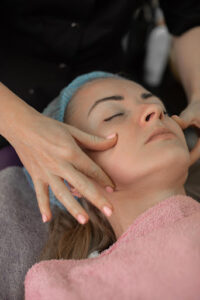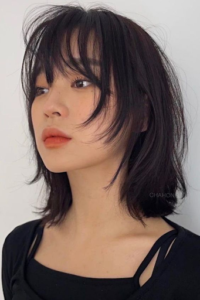What is an acupressure massage?
A manual therapy technique known as acupressure can be used to alleviate both chronic pain and acute muscle tension. Acupressure massage for back body is a technique that involves progressively applying pressure with the fingers to specific places all over the body in order to alleviate pain and relax the muscles. The trigger points found within muscles and other connective tissues are targeted by the acupressure treatment. A neuromuscular point is referred to as a trigger point when it is the site of irritation caused by the meeting of a muscle and a nerve. This gathering place frequently leads to painful muscle spasms and can cause discomfort when it is crushed. By interfering with the transmission of pain impulses to the brain and by inducing a state of profound relaxation, the acupressure massage for back body technique can frequently alleviate pain.
How does acupressure massage for back body work?
It is believed that blocked energy can be treated by acupressure; nevertheless, it is yet unknown exactly what it is that acupressure performs. Endorphins may be released as a result of the pressure, according to some people’s theories. These are the body’s own naturally occurring compounds that alleviate pain.Some people have the opinion that the pressure may have an effect on the autonomic nervous system. This is the component of the nervous system that is responsible for the automatic functions of the body, such as the heart, digestion, and breathing.
Traditional Chinese Medicine (TCM) postulates that the body contains unseen energy routes known as meridians, which circulate throughout the body. It is believed that the organs are connected to various regions of the body by a minimum of 14 different meridians.It is believed that health issues will arise anywhere along a meridian if the flow of qi is obstructed at any point along the pathway.In order to get healthy energy flow back into the body, a practitioner will apply pressure to certain acupressure spots. Your specific symptoms will determine the sites they select.Because of the way that meridians are laid out, the pressure points that are employed may be some distance from the actual location of the symptom. On the foot, for instance, there is an acupressure point that can be used to alleviate headache pain.
What are the few acupressure points?
In order to alleviate the discomfort produced by sinus pressure and congestion, the following are a few points that can be helpful.The depressions that can be found directly underneath the middle of the brow, in the space that is between the eyes and the nose.It is possible to reach the sides of the nostrils by sliding one’s fingers down from the brow.There are other spots just below the cheekbones (these two places are also useful for eye fatigue); they are located in the hollows of the cheeks.
You have probably heard of or seen travel accessories such as the motion sickness wristband. They apply pressure at precisely the same point:There are places located below the wrists on the interior of the forearm, in between two tendons, and in the space between the two. Other helpful regions for reducing headaches include the following, in addition to the pressure points utilised for alleviating pressure in the sinuses:
Acupressure points can be found in the webbing that connects your thumb and index finger; the precise location is at the highest section of the muscle. (*Pregnant women should avoid using this point because it can speed up the labour process.) In addition, there are five locations located on the rear of the neck. The first one can be found in the middle of the head, directly beneath the skull. The remaining four can be found on either side of this central location. Two are located immediately below, in the depression that exists between the vertical neck muscles. The last two are situated one-quarter of an inch below the base of the skull, on the vertical neck muscles.
6 acupressure point to relieve back pain
Find somewhere calm to practise, and focus intently on exerting pressure on each of these places for around one to two minutes at a time. You are free to perform this exercise as many times as you see fit.It is important that you are aware that you should NOT apply pressure to any of the acupuncture points that have been mentioned if you are experiencing severe chronic back pain. Instead, you should seek the guidance of an authority figure or a medical professional.
1. Stomach acupressure point:
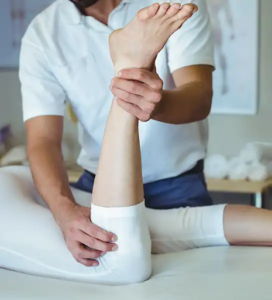
Source: https://www.bluetree-massage.com/en/6-self-acupressure-points-to-relieve-back-pain/
This particular acupressure point, known as CV6, can be found two fingers’ lengths below the belly button. Use your index or middle finger to exert a forceful amount of pressure.
2. Lower back acupressure points:
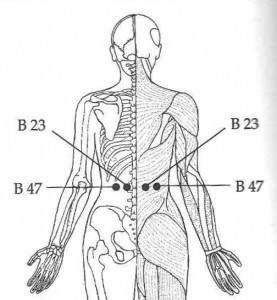
Source: https://www.bluetree-massage.com/en/6-self-acupressure-points-to-relieve-back-pain/
These points are located on both sides of the lower back, on either side of the spinal cord, two finger widths (B23) and four finger widths (B47) away from the spine at waist level, on either side of the lower back.You may find the points by placing your hands on your waist and moving your thumbs toward your spine. Once you’ve found them, apply hard pressure to the area.
3.Hip bone acupressure points:
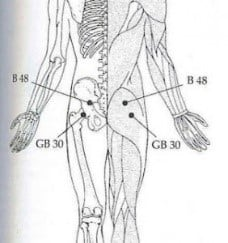
Source: https://www.bluetree-massage.com/en/6-self-acupressure-points-to-relieve-back-pain/
These points are located on both sides of the hip bone, roughly two finger widths away from the broad bony area at the bottom of your spine (B48), and exactly in the middle of the distance between the top of your hip bone and the base of your buttocks (GB30).Place a light, even pressure with your two thumbs on each of these pressure points located on each side.
4. Knee acupressure points:
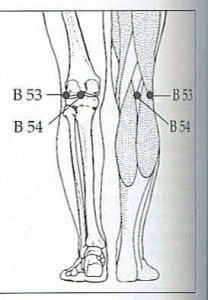
Source: https://www.bluetree-massage.com/en/6-self-acupressure-points-to-relieve-back-pain/
Two of the knee points, designated by the letter B54, are situated in the exact middle of the backspace of the knee, while the other two are somewhat offset to the outside.Either stand up with your hands on the side of your knees or sit down with your legs extended straight in front of you.Find the points in the hollow of the knee with your index or middle finger, and apply firm pressure to those points.
5. Hand acupressure points:

Source: https://www.bluetree-massage.com/en/6-self-acupressure-points-to-relieve-back-pain/
It is necessary to be lying down in order for the acupressure hand points known as 4GI to alleviate back discomfort.This point can be found two finger widths away from the joint that connects the thumb and the index finger.Apply pressure with the hand that does not have the picture on it to the point that is formed by the thumb and the index finger.After applying steady pressure on this point for a few seconds, you should then let up the pressure.This should be done four to five times. After that, move on to the other hand.
6.Foot acupressure points:
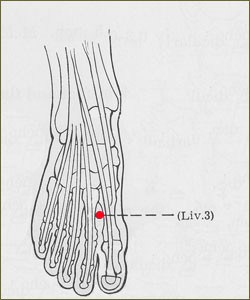
Source: https://www.bluetree-massage.com/en/6-self-acupressure-points-to-relieve-back-pain/
Get on your hands and knees and bend your right knee. Make an effort to get hold of your right foot with your right hand.This point is located between your big toe and second toe (Liv3), and it is situated two finger widths above the point where your big toe and second toe join together.Because this particular region may be a little sensitive, apply moderate to firm pressure with either your thumb or index finger.Do the same thing with your other foot.
Who gets back pain?
Back pain can affect anyone at any time, and almost everyone will have some degree of back discomfort at some point in their lives. Your likelihood of experiencing back discomfort is increased by a number of factors, some of which are as follows:
Fitness level: The incidence of back discomfort is significantly higher among individuals who do not have an adequate degree of physical fitness. For instance, if the muscles in the back and stomach are weak, the core may not be strong enough to support the spine adequately. If you have been idle for a while and then suddenly start engaging in rigorous activity (overdoing it), you may have back discomfort.
Weight gain: The combination of eating a diet that is rich in calories and fat and leading a lifestyle that is low in physical activity can contribute to obesity and weight gain. This could potentially cause strain on the back.
Job-related risk factors: Back injuries are common in professions that require heavy lifting, pushing, tugging, or twisting of the body. There’s also a possibility that your desk job is to blame, particularly if you have terrible posture or spend all day sitting in an uncomfortable chair.
Stress level: Back pain can be more severe and occur more frequently if you have a high level of stress, such as if you suffer from chronic insomnia, depression, or anxiety.
Age: Back discomfort is something that is more likely to occur as one gets older, especially beyond the age of 45.
Heredity: The presence of certain illnesses, such as those that cause back discomfort, may be inherited.
7 Acupressure points for upper back pain
There are around 350 acupressure points spread out across the body along the various meridians, also known as energy lines. When you press each pressure point, you are not only helping to relieve the discomfort associated with trigger points and releasing muscular knots, but you are also stimulating the flow of qi, which is sometimes referred to as vital energy. If you suffer from upper back discomfort and are interested in trying acupressure massage for back body as a treatment option, the following acupressure sites are some of the most frequently targeted by licensed massage therapists:
1) GB 21
Jian Jing is an acupressure point that is commonly used to treat a variety of painful conditions, including headaches, stiffness, shoulder stress, neck discomfort, and muscular knots. People who suffer from back or shoulder pain tend to have muscle fiber tension here more than elsewhere else in their bodies. However, it is essential to keep in mind that applying pressure to this acupressure point might produce contractions in pregnant women, thus it must be done so with extreme caution. The upper trapezius muscle contains the trigger point known as GB 21, which may be found at the top of the shoulder blade and approximately two fingers away from the base of the neck.
2) GB 10
The GB 10 acupressure point is located around one thumb’s width below the base of the skull and another thumb’s width from the spine. When sustained, firm pressure is applied to this location, the tension in the tight muscle in the surrounding area is relieved, which ultimately results in pain relief in the neck and head. This pressure point also works to boost the hormonal systems of the body, which results in enhanced pain alleviation and a more relaxed state of mind. If you want to get the most relief from your upper back discomfort, you should make sure to apply pressure to this trigger point for around two to three minutes at a time and numerous times throughout the day.
3) TE 3
The following point, which is also referred to as the central islet, may be found directly behind the knuckles of the fourth and fifth fingers. Patients who have back discomfort, neck strain, shoulder stress, or headaches in the temporal region may find alleviation from these symptoms when the groove between the tendon is pressed. Once you have located the TE 3, position the thumb of the hand that is not holding the TE 3 over it, and then apply significant force to the groove. Maintain the pose for around four to five seconds at a time, and then perform the exercise multiple times each day.
4) LI 4
One other acupressure point in the hand is known as the LI 4, and it may be discovered in the web space between the index finger and the thumb. You may locate it by pressing the tips of your thumb and index finger together, which will cause a lump to appear in the muscle. The LI 4 represents the most elevated point of the hump.The accumulation of stiffness and facial strain that occurs throughout the day can be alleviated by routinely applying pressure on the LI 4 point. In addition, it can help alleviate discomfort in the head and toothache, as well as in the upper back.
5) K 27
Because it relieves stress in the throat, chest, and upper back, the K 27 acupressure point is an important trigger point. It is located on both sides of the body around one fingertip below the collarbone. Patients are able to take full, deep breaths and, as a result, release endorphins, which are essential for lowering tension and relieving pain when this acupuncture point is stimulated.Once you have located the K 27, use the hand on the other side to apply sustained pressure to the acupressure point for a few seconds at a time. Rub the area in a circular motion while maintaining an adequate amount of pressure, as this helps relieve some of the tension there.
6) GV 14
The acupressure point known as GV 14 is located on the upper back, more particularly in the middle of the upper back at the level of the shoulders. When pressure is applied to this location, you will get relief from pain and stiffness in the area of your shoulders and neck. Patients who suffer from cervical spondylosis might also benefit tremendously from the usage of this treatment.
The patient remains seated throughout the massage therapy session as the therapist delivers pressure to the GV 14 for approximately one minute. The patient’s level of comfort and tolerance for discomfort should be taken into consideration before applying pressure to this trigger point.
7) SI 15
An acupressure point known as the SI 15 can be found in the patient’s center area, approximately two finger widths away from the spine. When pressure is applied to this point, it relieves pain in the neck and back caused by cervical spondylosis, which is a disorder caused by the wear and tear of the cartilage and bone in the cervical spine. The SI 15 is useful for reducing stress, pain, and tension in the upper and middle back, which is another area of the body that it targets. However, because patients are unable to reach the SI 15 on their own, they require the assistance of a trained therapist who will apply pressure to the area using their thumb or knuckles for around one to two minutes.
Can You Perform Acupressure for Upper Back Pain at Home?
Because there is a lot of information regarding the location of acupressure points and what to do with them that can be found on the internet, many people are curious about whether or not it is safe to practise self-administered acupressure massage for back body therapy at home.There isn’t a lot of research that looks at how acupressure massage for back body can help alleviate upper back discomfort when it’s done at home. However, a study that was conducted at the University of Michigan found that self-applied acupressure massage for back body can help alleviate chronic pain in the lower back; therefore, it is reasonable to infer that it also works for pain that is experienced in the upper back.However, in order to save yourself from injuring yourself when performing self-acupressure, it is essential to follow the recommendations provided by a trained practitioner. This is the case with any at-home treatment for back pain. It is essential that you are able to spot the signs that indicate that acupressure massage for back body may no longer be effective for you. This will allow you to discuss your situation with a pain management specialist.
Acupressure point for lower back pain relief
Urinary Bladder 60 (UB 60)
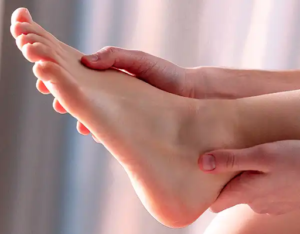
Source: https://www.bluetree-massage.com/en/6-self-acupressure-points-to-relieve-back-pain/
- The application of pressure to this point will assist alleviate discomfort in the lower back as well as the lower leg.
- Put your index finger on the end of the bone that protrudes from the outside of your ankle.
- If you move your finger back towards the Achilles tendon, you should find that there is a space for it to fit into.
- Now, exert pressure at this location for a period of time ranging from 30 seconds to three minutes.
Urinary Bladder 40 (UB 40)
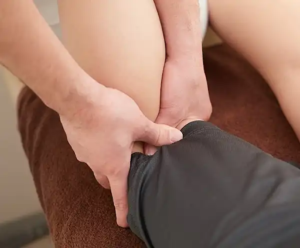
Source: https://www.bluetree-massage.com/en/6-self-acupressure-points-to-relieve-back-pain/
- This acupuncture point, which may be found in the rear of the leg, is beneficial for treating muscle spasms in the low back, as well as hip discomfort and sciatica.
- Put your finger so that it is pointing directly at the crease that can be found on the back of the knee.
- When your knee is slightly bent, it will be much simpler for you to locate the precise location.
- Check that your finger is positioned such that it is directly in the middle and beneath the kneecap.
- Apply steady pressure to this region while you hold it for at least a minute.
Large Intestine 4 (LI4)
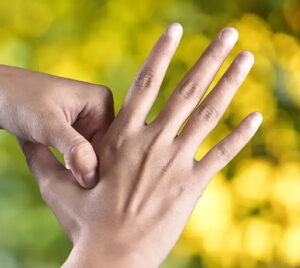
Source: https://www.bluetree-massage.com/en/6-self-acupressure-points-to-relieve-back-pain/
Lower back discomfort can be alleviated by applying pressure to the LI4 acupuncture point, which is found on the palm side of the hand, on the web of the thumb. If the pain is localised to one side of the body, then you should apply pressure to the point on the hand that is on the opposite side.
- Take the thumb of your right hand and place the joint of the thumb on the webbing of the hand on the other side of your body (between the thumb and the forefinger).
- Now, press down on the LI4 point with the very tip of your thumb while maintaining the flattened position of the thumb.
- Maintain the press for at least thirty to sixty seconds at a minimum.
Gall Bladder 34 (GB 34)

Source: https://www.bluetree-massage.com/en/6-self-acupressure-points-to-relieve-back-pain/
The GB 34 acupoint, which is positioned on the outer aspect of the knee, has been shown to be effective in treating musculoskeletal pain problems including sciatica.
- First, find a chair to sit in and use your hand to feel for a bony lump that is just below and outside of the knee cap.
- Make a diagonal motion downwards with your finger until it reaches the space between this bone and your shin bone.
- The site of application of pressure should be at the part that is the most tender.
- If you want the best effects, you should apply pressure on this area for at least two to three minutes.

